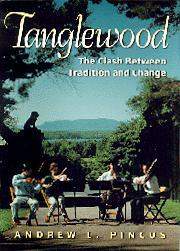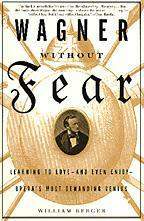Book Reviews
November 1, 1998
Version française...
 In
Tanglewood: The Clash between Tradition and Change, Andrew L. Pincus traces the
history of the firings and resignations that have swept away the Tanglewood
Festival’s old guard over the last two years (when necessary, Pincus repeats material
from his previously published Scenes from Tanglewood, which covered the years
1975-1988). Pincus, for 23 years a music critic for the Berkshire Eagle and
contributor to the Boston Globe and the New York Times, is a defender of
inherited standards of quality, but he is no reactionary. He has a sense of humour, and he
is open to innovations that work. He also puts journalistic integrity above special
pleading and personal agendas, unlike many other culture critics from both extremes of the
political spectrum. In
Tanglewood: The Clash between Tradition and Change, Andrew L. Pincus traces the
history of the firings and resignations that have swept away the Tanglewood
Festival’s old guard over the last two years (when necessary, Pincus repeats material
from his previously published Scenes from Tanglewood, which covered the years
1975-1988). Pincus, for 23 years a music critic for the Berkshire Eagle and
contributor to the Boston Globe and the New York Times, is a defender of
inherited standards of quality, but he is no reactionary. He has a sense of humour, and he
is open to innovations that work. He also puts journalistic integrity above special
pleading and personal agendas, unlike many other culture critics from both extremes of the
political spectrum.
Tanglewood was founded in the 1930s by Boston society women to give
New England a summer festival akin to those in Europe. The Berkshire Mountains had long
been the summer resort of New York and Boston high society, so a rich, bored audience was
already in residence there. In 1936, the 210-acre Tanglewood estate was donated by two
Boston women, and Russian conductor Serge Koussevitsky (known as Couscous to his friends)
joined the enterprise, which he led until his retirement in 1948. In 1938, the open-sided
5,000-seat Music Shed (which remains Tanglewood’s main symphonic hall) was built, and
the Theatre-Concert Hall for opera was opened in 1941. Over the next 40 years, Tanglewood
served as a training ground for dozens of conductors and musicians who went on to
international fame. In 1986, Tanglewood acquired the neighbouring 120-acre Highwood
estate, now called the Bernstein Campus, and in 1994 the beautiful new $9.7 million,
1,180-seat Seiji Ozawa Hall opened. Pincus devotes a fascinating chapter to the
development and building of Seiji Ozawa Hall, one of America’s few acoustically and
aesthetically successful modern concert halls.
Despite an enviable record of artistic and financial success,
Tanglewood was split by philosophical differences. By the early 1990s, the Tanglewood
teaching staff, administration and many Boston Symphony musicians had grown disillusioned
with Seiji Ozawa, BSO director and hence Tanglewood’s boss since 1973. Ozawa is a
typical jet-set conductor, spending the minimum amount of time contractually possible with
each of his orchestras, while pulling down multi-million dollar salaries on three
continents. By all accounts, Ozawa’s conducting is frequently uninspiring. Under his
leadership, the BSO’s musical reputation has slipped considerably from its glory days
under Koussevitsky and Leinsdorf, while its public profile has been polished by television
coverage and clever media relations. The Tanglewood community finds it hard to understand
why Ozawa, who has spent over 20 years at the head of two quintessentially American
institutions, still speaks broken English and prefers to spend as much time as possible in
Japan (ironically Ozawa was accepted in Japan only after he had made good in the United
States).
The gulf between Ozawa and Tanglewood climaxed with the 1996 firing
of respected administrative director Richard Ortner, followed by the 1997 departures of
faculty chairman Leon Fleisher, manager Daniel Gustin and professor Gilbert Kalish. Pincus
links these purges to the increasing commercialization of Tanglewood through televised
concerts, pop and jazz events, video projects, and exclusive new facilities for rich
donors. For better or worse, Tanglewood’s new direction is seen by its current
leaders as essential to its relevance and survival into the millennium. Pincus’s
fact-filled institutional biography tells the story compellingly but fairly.
- BBC Music Magazine Top 1000 CDs Guide
- Edited by Erik Levi and Calum MacDonald
- BBC Books 1996. 367 pp. ISBN 1-57467-018-2. $12.95 US
This buyers’ guide is compiled from CD reviews already
published over the last year in the commercially-oriented, industry-friendly glossy
monthly BBC Music Magazine. The CD reviews are grouped under the following
headings: chamber music, choral and song, instrumental, opera and orchestra. There are
many problems with this guide: the reviews are not sufficiently comparative (for many
major works such as Beethoven’s Violin Concerto or Verdi’s Rigoletto,
there is only one recommendation); the reviews are not dated, so it is impossible to
contextualize terms like "recent"; reviews are often whimsically wrong; recent
releases, however poor, are consistently recommended over established benchmark recordings
(obviously because record companies prefer to sell their new, full-price releases instead
of back catalogue). Many of the recordings in this 1996 guide have already been superseded
or deleted. In short, you are better off checking a dusty old Penguin Guide, or the
archives of Gramophone and Fanfare magazine on the web.
- William Berger : Wagner Without Fear
- Vintage 1998. 443 pp. ISBN 0-375-70054-4
$21 Can. pb.
 Berger’s
comprehensive beginners' introduction to Wagner’s major operas (he skips Rienzi)
is one step up from Wagner for Dummies. For each opera, Berger (a librettist and
linguist) provides useful act-by-act plot guides, performance history, opera lore
(anecdotes, potted biographies), brief discographies and bibliographies, and a description
of each opera’s characters and their voice types. Alas, Berger also serves up
intolerable chapters of cultural pabulum pandering to the much-discussed but rarely seen
Mythic Opera America Novice (or MOAN), an imaginative creation of the opera
industry’s audience development thinktank. To judge by the flood of recent beginners'
opera guides supposedly written to lure willing but nervous novices into opera houses, the
average MOAN is a rural American with a grade-ten education who a priori hates
anything that looks like high culture (the dumb and dumber glossary includes an
explanation of the obscure terms Bavaria, Kaiser and libretto). The average MOAN has a
very short attention span, hence Berger’s therapeutic "Rough Spots and how to
get through them". The MOAN is also either infantile or senile, hence the
hand-holding "When to eat, drink and visit the restroom" chapters. Most MOANs
seem to have an inferiority complex, hence the chapter "Lobby Talk", so they can
be instant intermission experts. MOANS don’t like surprises, so Berger prepares them
with "Productions : what you might expect to see." But enough already. The whole
exercise seems like a satire on outreach and relevance. If people are so reluctant to
attend opera that they need a therapy manual before they’ll buy a ticket, it would
seem more humane to leave them in front of their television sets. Berger’s
comprehensive beginners' introduction to Wagner’s major operas (he skips Rienzi)
is one step up from Wagner for Dummies. For each opera, Berger (a librettist and
linguist) provides useful act-by-act plot guides, performance history, opera lore
(anecdotes, potted biographies), brief discographies and bibliographies, and a description
of each opera’s characters and their voice types. Alas, Berger also serves up
intolerable chapters of cultural pabulum pandering to the much-discussed but rarely seen
Mythic Opera America Novice (or MOAN), an imaginative creation of the opera
industry’s audience development thinktank. To judge by the flood of recent beginners'
opera guides supposedly written to lure willing but nervous novices into opera houses, the
average MOAN is a rural American with a grade-ten education who a priori hates
anything that looks like high culture (the dumb and dumber glossary includes an
explanation of the obscure terms Bavaria, Kaiser and libretto). The average MOAN has a
very short attention span, hence Berger’s therapeutic "Rough Spots and how to
get through them". The MOAN is also either infantile or senile, hence the
hand-holding "When to eat, drink and visit the restroom" chapters. Most MOANs
seem to have an inferiority complex, hence the chapter "Lobby Talk", so they can
be instant intermission experts. MOANS don’t like surprises, so Berger prepares them
with "Productions : what you might expect to see." But enough already. The whole
exercise seems like a satire on outreach and relevance. If people are so reluctant to
attend opera that they need a therapy manual before they’ll buy a ticket, it would
seem more humane to leave them in front of their television sets.
- Phil G. Goulding : Ticket to the Opera
- Fawcett Columbine, 1996. ISBN 0-449-90900-x
689 pp.
Phil Goulding is a self-confessed amateur opera lover who learned
everything he knows about music since he retired from politics ten years ago. Why are
these self-taught late bloomers such rabid proselytizers for opera? Goulding comes across
as a crusty old septuagenarian with a woefully antiquated sense of humour and an
insatiable appetite for listening to his own patronizing lectures. Alas, the pompous bore
who wants to share his passion is the worst apologist for opera. You’d have to be
almost illiterate to find Goulding’s dumbed-down prose and recycled platitudes
interesting, but he seems to know his audience, dedicating this book to "the Opera
Unwashed." They can have it, though they probably won’t want it.
Version française... |
|


